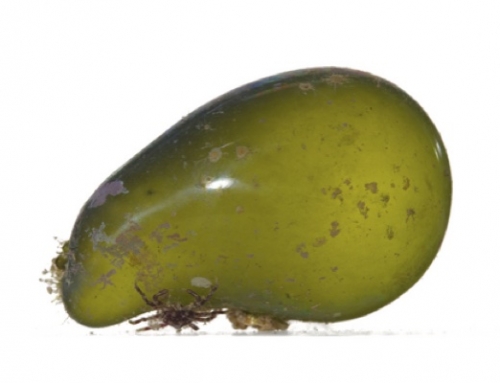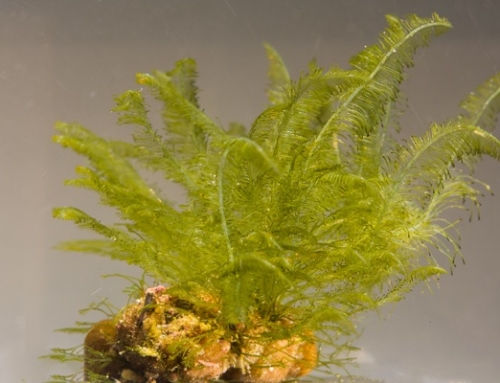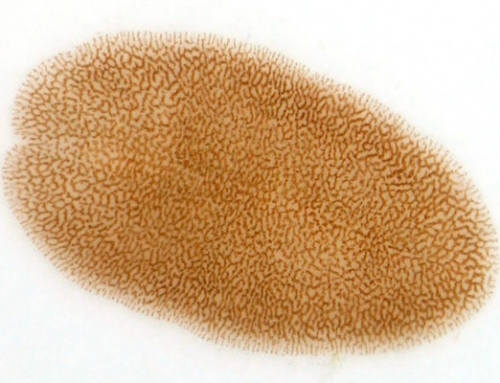Dinoflagelados, ¿buenos o malos?
Los dinoflagelados son organismos protistas -aquellos que no pueden clasificarse dentro de los tres reinos naturales: animalia, plantae o fungus- con capacidad para desplazarse con movimientos giratorios. Todos los dinoflagelados tienen la característica común de disponer de dos flagelos ubicados perpendicularmente lo cual les permite realizar dicho movimiento giratorio que los hace fácilmente reconocibles (aunque algunas especies como las pertenecientes al género symbiodinium son prácticamente inmóviles).
Se conocen aproximadamente 2.400 especies las cuales tienen un tamaño muy variable que oscila entre 20 y 300 µm en los más habituales y hasta 2 mm en el caso de especies como la noctiluca. En el acuario marino suelen ser habituales las especies de menor tamaño como symbiodinium y amphidinium, si bien algunas como la ostreopsis son grandes y puede verse sin necesidad de microscopio (con buena iluminación y agudeza visual).

Entonces, ¿dónde está el problema?
Los dinoflagelados son organismos presentes en cualquier acuario, de hecho son necesarios para su buen funcionamiento. Constituyen parte importante del primer escalón de la cadena trófica por lo que si utilizamos un microscopio los encontraremos en mayor o menor medida. Incluso tenemos célebres dinoflagelados como las zooxanthelas, presentes de manera simbiótica en la mayoría de los corales.
El problema surge cuando en el acuario se producen unas condiciones que rompen el equilibrio biológico y algunas especies de dinoflagelados se reproducen de forma descontrolada, asfixiando al resto de los habitantes del acuario. Si la especie de dinoflagelado en cuestión tiene capacidad para producir toxinas (habitual en ostreopsis, gambierdiscus y prorocentrum por citar algunas), entonces podemos prepararnos para una catástrofe.
Ninguna especie de dinoflagelado, incluyendo a la temida ostreopsis, debe ser motivo de preocupación siempre que sigamos unas pautas básicas que garanticen el equilibrio biológico de nuestro acuario. El problema muchas veces surge cuando intentamos llevar la limpieza del mismo al límite, con el fin de mejorar su aspecto y el color de los corales.
El bueno, el feo y el malo
Como comentaba anteriormente, no todos los dinoflagelados son malos, algunos son buenos e incluso necesarios. Una característica común de estos organismos es su asombrosa capacidad reproductiva, lo cual puede hacer que incluso los más beneficiosos lleguen a convertir un precioso acuario en una horrible ciénaga, en pocas horas.
Podemos clasificarlos en dos grupos funcionales: autótrofos y heterótrofos:
Dinoflagelados autótrofos
Son los que más nos deben preocupar ya que no dependen de fuentes orgánicas externas para prosperar. Son organismos fotosintéticos capaces de fabricar su propio alimento incluso cuando apenas disponen de nitratos y fosfatos inorgánicos. Sus principales ventajas son su enorme resistencia a situaciones extremas, así como su capacidad reproductiva. Suelen manifestarse repentinamente cuando el agua del acuario alcanza una pureza extraordinaria, en la que la mayoría de los microorganismos perece por falta de alimentos. Sin otros organismos que les pongan freno, este tipo de dinoflagelado puede multiplicarse a tal velocidad que cuando queramos darnos cuenta ya es tarde y encontraremos un acuario lleno de babas marrones y ocres que asfixian a peces e invertebrados.
Esos dinoflagelados poseen cloroplastos que les permiten sintetizar sus propios alimentos incluso con una mínima cantidad de luz. Algunas especies pueden formar quistes de resistencia llamados pellicles que les permiten permanecer en el acuario durante meses aunque lo hayamos esterilizado por completo o mantenido en completa oscuridad. Una vez vuelve la luz o las condiciones adecuadas, volverán a aparecer y con ello los problemas.
La mayoría de estos dinoflagelados tienen un comportamiento muy curioso, típico de organismos patógenos y parásitos. Con presencia de luz son bentónicos, segregan una mucosidad con la que se adhieren a cualquier superficie, incluidas algas, corales y peces. Pasan las horas sintetizando alimentos y extendiéndose verticalmente en busca de la fuente de luz (si apagamos las bombas en el acuario podremos ver crecer filamentos marrones hacia la superficie). Cuando desaparece la fuente luminosa y ya no pueden sintetizar alimentos, se desprenden de las mucosidades que habían fabricado y emprenden una etapa pelágica, dejándose llevar por las corrientes para colonizar nuevas zonas.
Dinoflagelados heterótrofos
Son los que necesitan de una fuente de nutrientes orgánicos para poder vivir. Normalmente son organismos buenos en un acuario ya que su capacidad reproductiva es moderada y por ello fácilmente controlables. Algunos de ellos como la oxyrrhis marina se alimentan de otros dinoflagelados, por lo que ayudan a su control. Su presencia en los acuarios, si bien es habitual, está limitada a muy pocas especies y densidades poblacionales muy bajas.
…y el demonio
Si a una de estas especies autótrofas le añades la posibilidad de fabricar toxinas.
Es el caso de la archiconocida ostreopsis (pero hay bastantes como ciertas especies de prorocentrum, gyrodinium y gambierdiscus por citar algunas de las más habituales)
Con nombre propio: ostreopsis
Un dinoflagelado casi desconocido entre los aficionados a los acuarios apenas hace cuatro años, es ahora un personaje popular. La ostreopsis, principal causante de las conocidas «mareas rojas» .



¿y por qué es tan especial?
Muy sencillo: conjuga todos los ingredientes posibles para arruinar un acuario:
- Elevada capacidad reproductiva. En condiciones favorables podemos ver cómo se extiende ante nuestros ojos. Basta con apagar las bombas de circulación y encender las luces para ver hilos de mucosa ocre ascender y alcanzar la superficie en pocos minutos.
- Tamaño. Es uno de los dinoflagelados más grandes que podemos encontrar en nuestro acuario, llegando a alcanzar los 60 µm en su parte más alargada. Eso hace que la mayoría de ciliados no puedan depredar sobre ellos y controlar su expansión. Por otro lado no es infrecuente que se agarren a los ojos y agallas de los peces provocando en ellos picores y estrés.
- Toxicidad. Es capaz de producir una potente toxina que matará a cualquier organismo que la ingiera, especialmente gasterópodos y peces herbívoros que pueden confundirla con otras algas por el olor a sulfuro de dimetilo.
- Facilidad para formar pellicles. Cuando este dinoflagelado se siente amenazado o no encuentra las condiciones óptimas para prosperar, se protegerá formando un quiste capaz de resistir durante semanas y meses incluso fuera del agua.
A la izquierda podemos ver una imagen de ostreopsis ovata al microscopio electrónico en la que se aprecia la unión de las thecas y flagelos, una imagen de un coral asfixiado por esta especie de dinoflagelado y por último una imágen de una marea roja causada por ostreopsis
Cada vez son más frecuentes los casos de ostreopsis en los acuarios marinos. Este dinoflagelado se ha convertido en una auténtica plaga, amenazando muy especialmente a aquellos con sistemas de nutrientes ultra bajos (ULNS) que buscan una coloración pastel en sus corales.
Los primeros síntomas de que se avecina un problema
La velocidad a la que pueden proliferar los dinoflagelados es tan alta que normalmente los detectamos cuando ya se ha ensuciado una gran parte del acuario y sus habitantes empiezan a mostrar afecciones. Los primeros síntomas de un ataque de dinoflagelados suelen ser los siguientes:
- Aparición de baba de color marrón y ocre en las zonas más iluminadas y de mayor corriente. A estos bribones oportunistas les encanta agarrarse a las zonas más agitadas y expuestas a la luz, eso les provee de energía y nutrientes inorgánicos para poder sintetizar sus propios nutrientes orgánicos de los que se alimenta.
- Aparición de caracoles y pequeños invertebrados herbívoros muertos.
- Comportamiento nervioso de algunos peces.
- Descenso importante en el pH del acuario en ausencia de luz.
Cómo combatir los dinoflagelados autótrofos, reglas básicas
Lo primero que debemos hacer es identificar la especie o al menos la familia a la que pertenece. Algunos dinoflagelados son organismos banales, no tóxicos y generalmente muy delicados que pueden ser eliminados con alguno de los productos comerciales diseñados para ello (Dino X, Dino Remove o Dinoxal), otros incluso pueden ser eliminados mediante el uso de potentes oxidantes como el peróxido de hidrógeno o la instalación de un generador de ozono. No obstante, la mayoría de los dinoflagelados que suelen proliferar en el acuario suelen ser más difíciles de eliminar y deberemos aplicar soluciones completamente opuestas, encaminadas a fomentar la competencia biológica con otros microorganismos. Por lo tanto si no identificamos la especie de dinoflagelado y usamos alguno de los productos citados anteriormente, es posible que empeoremos el problema al contribuir a eliminar muchos de los organismos con los que compiten.
Lo que debemos hacer
Apagar el skimmer
Esta suele ser la medida más efectiva para contener el avance de los dinoflagelados. En contra de lo que la mayoría piensa, el skimmer es poco más que un aparato eficiente para retirar bacterias y contaminantes polares, así como una ayuda para oxigenar el agua. A los dinoflagelados les encantan los entornos ricos en oxígeno y pobres en biodiversidad por lo que apagando el skimmer no tardaremos en notar un importante alivio en la lucha contra los dinoflagelados.
Programar las bombas a mínima potencia
Las bombas no solo oxigenan el agua, lo cual es del agrado de los dinoflagelados, también ayuda a que colonicen todo el acuario transportándolos a todos los rincones del mismo. Es muy importante disminuir el caudal de las bombas al mínimo o incluso apagar las que no son extrictamente necesarias.
Proveer al acuario de microorganismos competentes, aumentar la biodiversidad
Por insignificante que pueda parecer, añadir un par de kilos de roca viva nueva, utilizar comida viva (copépodos, anfípodos, mysis…) o algo de arena procedente de un acuario maduro puede ayudar mucho a restablecer el equilibrio biológico en el acuario y poner freno al avance de los dinoflagelados.
Alimentar el acuario
No debemos olvidar las causas que han fomentado la aparición de los dinoflagelados, especialmente el haberlo convertido en un entorno casi estéril al limitar la entrada de alimentos o tener pocos o ningún animal que ensucie ligeramente el agua y con ello aporte los nutrientes mínimos para conservar la biodiversidad.[sociallocker]Muchas veces se trata de una brusca bajada en los nutrientes inorgánicos porque hemos hecho repetidos cambios de agua, instalado un skimmer muy potente o abusado de resinas contra los fosfatos lo que hace que disminuya mucho la biodiversidad y concentración de los organismos competentes. Por ello no debemos fiarnos si al hacer un test comprobamos que los nitratos y/o fosfatos están altos: también en este escenario aparentemente desfavorable podemos provocar la aparición de los dinoflagelados, especialmente si cometemos alguno de estos abusos que conducen a reducirlos bruscamente.
Recomiendo el uso de fitoplancton de forma regular, ya sea vivo o en forma de gel y mediante el uso de una bomba dosificadora. También ayuda mucho el uso esporádico de alimentos húmedos como mysis, calanus o artemia
Instalar un germicida ultravioleta
Antes comentábamos una generalidad de los dinoflagelados autótrofos: de día son bentónicos y de noche pelágicos.[/sociallocker]Si instalamos un germicida ultravioleta, y lo hacemos funcionar por la noche mataremos a muchos de ellos cuando estén flotando en el agua. No los eliminaremos por completo pero si el equipo es suficientemente potente disminuiremos notablemente su expansión.
Utilizar carbón activo
Cuando los dinoflagelados empiezan a morir, las toxinas se liberan en el agua. Está demostrado que el carbón activo (especialmente si es bituminoso) ayuda a retirar estos contaminantes eficazmente. A diferencia de las resinas de intercambio iónico tan populares, el carbón activo no frena la proliferación de otros microorganismos que compiten con los dinoflagelados.
Sifonar al atardecer empleando un filtro calcetín
Es a última hora del día cuando mayores son las masas de dinoflagelados y cuando más fácil es retirarlos. Como veremos más adelante no es conveniente hacer cambios de agua, por ello podemos proceder instalando un filtro calcetín en el sump (recomiendo emplear uno no superior a 150 µm) y aspirar la baba mediante un tubo flexible.
Observar la evolución con un microscopio
Cualquiera de las anteriores acciones suelen producir una respuesta satisfactoria en la lucha contra los dinoflagelados. La mejor manera de comprobarlo es mediante la observación al microscopio: podremos ver que vamos por buen camino si la movilidad de los dinoflagelados disminuye (solo en algunas especies ya que otras han perdido la función motora o la tienen muy atrofiada), si vemos thecas desprendidas o si disminuye la concentración de los mismos. También es conveniente observar si van apareciendo otros microorganismos como nematodos, ciliados, dinoflagelados heterótrofos…



Lo que NO debemos hacer
Cambios de agua
Si hay algo que adoran los dinoflagelados es los cambios de agua. Con los cambios de agua introducimos los oligoelementos necesarios para que proliferen los dinoflagelados, especialmente hierro, yodo y silicio. Por lo tanto deberemos evitar hacer el mínimo aporte de agua nueva a nuestro acuario al menos durante un mes después de que los dinoflagelados hayan desaparecido de nuestra vista.
Utilizar fuentes de carbono
¿Alguna vez has usado alcohol para avivar una barbacoa? pues eso es lo que pasa si utilizas fuentes de carbono en un acuario con dinoflagelados: se extenderán irremediablemente en cuestión de minutos. Debemos evitar muy especialmente cualquier sustancia que contenga azúcares, vinagre o etanol como el famoso NO3:PO4-X de RedSea o NP-Out de Xepta Reef. El uso de bacterias desnitrificantes no está contraindicado pero en la mayoría de los casos es irrelevante.
Utilizar resinas antifosfatos
En la mayoría de los casos que conozco (y no son pocos) el desencadenante de los dinoflagelados es atribuible a la colocación de resinas antifosfatos. Cuando usamos estos productos, provocamos una rápida bajada de fosfatos inorgánicos, esenciales para la vida de pequeños microorganismos como ciliados, otros dinoflagelados heterótrofos, nematodos o copépodos. Muchos de estos microorganismos mueren repentinamente dejando paso libre a los dinoflagelados. Es por este motivo que cada vez son más frecuentes los acuarios con elevados niveles de fosfatos en los que podemos encontrar masas descontroladas de dinoflagelados y cianobacteria; posiblemente el peor escenario imaginable, no por feo y desagradable, sino porque suele resultar muy difícil devolverlo a su equilibrio biológico.
Aditar oligoelementos
Como ya comentaba en el primer punto, los dinoflagelados necesitan determinados oligoelementos para prosperar. Es muy importante evitar cualquier derivado del hierro, yodo, silicio y potasio. Muy especialmente el yoduro potásico habitualmente empleado en los acuarios de SPS.
Soplar la baba
Los dinoflagelados fabrican una mucosidad para mantenerse adheridos a cualquier superficie. Resulta fácil y tentador emplear una bomba para despegar estas babas de las rocas y sustrato ya que aparentemente desaparecen del acuario. Lo que realmente estaremos haciendo es esparcir el problema y los dinoflagelados colonizarán zonas nuevas del acuario. Los corales también se verán afectados y no tardaremos en ver cadenas de dinoflagelados colgando de sus puntas, especialmente en las zonas con mayor corriente de agua.
Emplear agentes oxidantes
A menos que estemos tratando de eliminar determinadas especies de amphidinium, symbiodinium o cualquier otro dinoflagelado de los considerados banales, debemos evitar el uso de generadores de ozono, peróxido de hidrógeno o cualquier producto comercial que no haya sido debidamente probado con la especie de dinoflagelado que queremos eliminar. Es por este motivo que recomiendo siempre intentar identificar la especie (o al menos la familia a la que pertenece el dinoflagelado que queremos eliminar). La mayoría de los productos comerciales son completamente ineficaces contra ciertas especies de dinoflagelados como por ejemplo la ostreopsis y pueden causar males mayores al limitar la expansión de otros microorganismos beneficiosos a la vez que debilitar corales y otros invertebrados.
Intercambiar peces o invertebrados
Es de sentido común, si nuestro acuario sufre una infección de dinoflagelados no es muy ético intercambiar ni siquiera un caracol con otros aficionados ya que les estaremos transmitiendo el problema. Si se trata de dinoflagelados con capacidad para formar pellicles, caso de la ostreopsis, una cuarentena de al menos tres meses es recomendable antes de vender o intercambiar cualquier animal de nuestro acuario, aún así no hay garantías de que no vayamos a transmitir estos dinoflagelados.
Esterilizar el acuario o cualquiera de sus elementos
No funciona en la mayoría de los casos y mucho menos con los dinoflagelados mencionados en el punto anterior. Hay personas que piensan que dando un baño con agua dulce a una roca va a eliminar los dinoflagelados, y tienen razón, pero no tienen en cuenta que con solo dinoflagelado que sobreviva (atención a los que forman pellicles) en una roca estéril y sin ningún tipo de microorganismo que pueda competir, se enfrentará a un verdadero problema. Hablo bajo la experiencia de haber bañado rocas con ostreopsis en agua dulce con altas concentraciones de peróxido de hidrógeno y a los pocos días de reintroducirlas en un acuario también esterilizado encontrarme con un problema mayor.
Otros métodos de combate
Existen organismos con capacidad para matar ciertos dinoflagelados autótrofos, entre los que caben destacar los siguientes:
- Parvilucifera sinensis. Es un diminuto parasitoide de la mayoría de los dinoflagelados. Cuando la parvilucifera detecta la presencia de un dinoflagelado se acerca y penetra a través del intersticio entre las thecas. Tras ello comienza a multiplicarse rápidamente y en pocas horas habrá llenado el interior del dinoflagelado de diminutas réplicas de sí misma. El dinoflagelado revienta debido a la presión interna, liberando docenas de nuevos parasitoides que seguirán atacando a otros individuos. El problema de la parvilucifera es que es muy delicada y apetecible a la mayoría de microorganismos, especialmente los ciliados, por lo que no siempre funciona. Si la empleamos contra dinoflagelados como la ostreopsis obtendremos resultados temporales ya que algunos consiguen protegerse en un pellicle y cuando la parvilucifera haya desaparecido volverán a hacer acto de presencia.
- Hongos. Algunos dinoflagelados pueden ser muy sensibles al ataque de determinados hongos.
- Otros dinoflagelados. Se ha podido constatar que dinoflagelados como la oxyrrhis marina depredan sobre dinoflagelados como la ostreopsis ovata.
Es importante insistir en que la mejor defensa contra los dinoflagelados consiste en mantener un adecuado equilibrio biológico evitando llevar el acuario a situaciones de limpieza extrema en las que los dinoflagelados no encontrarán competencia. Si nuestro acuario cumple esta condición no hay motivo para temer a los dinoflagelados, incluso se pueden introducir animales provenientes de un acuario con dinoflagelados visibles sin riesgo a una infección.





Deja tu comentario
Debe iniciar sesión para escribir un comentario.